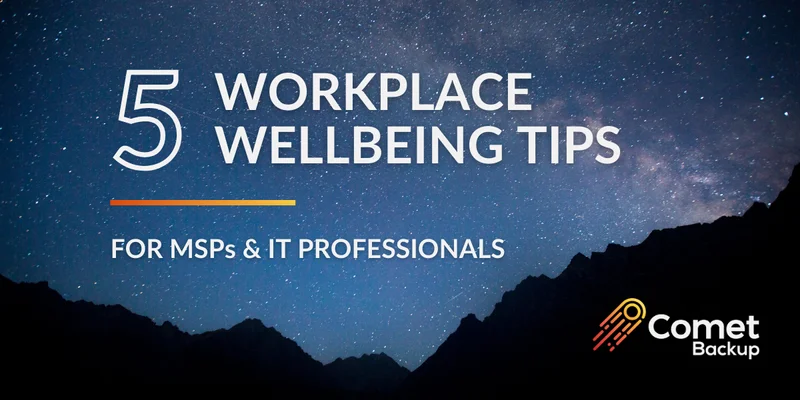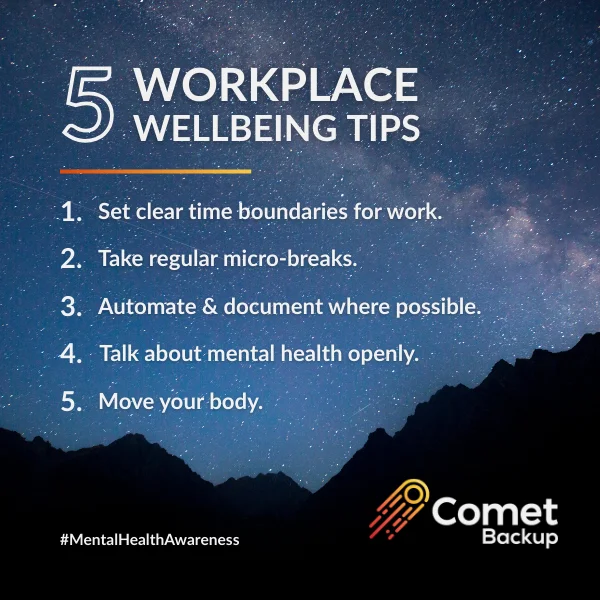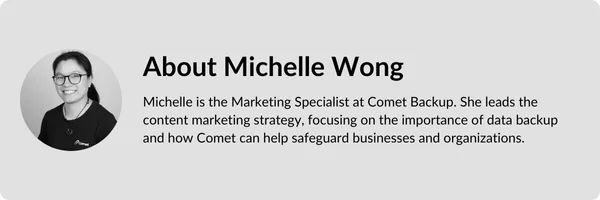Written by Michelle Wong - Marketing Specialist

May marks Mental Health Month in the US and Mental Health Awareness Week in the UK (May 12-18, 2025). It’s the perfect time to talk about something that is often overlooked in the workplace: our mental wellbeing and how we’re really doing.
At Comet Backup, we care about keeping our team healthy and happy. Every Friday, we share a quick wellness tip during our all-hands meeting, and we’ve got a Slack channel dedicated to wellbeing tips, healthy recipes, and other resources.
We want to help start the conversation and share some tips and ideas to help support you and your technicians.
So, what is Mental Health Awareness all about?
It’s about understanding that mental wellbeing matters just as much as physical health. It's also about breaking the stigma around mental health struggles—and making it easier to speak up, check in, and ask for help when needed. We want to help encourage having open conversations in the workplace.
Why It Matters in the IT World
Working in IT and managed services often means long hours, on-call stress, and high-pressure environments and expectations. Whether you're jumping between urgent support tickets or juggling multiple client needs, burnout can creep in fast if you're not careful.
As an MSP or IT professional, do some of these challenges sound familiar?
- Always on-call: After-hours alerts and weekend fixes can wear you down.
- Constant firefighting: Solving problems all day, every day, with little breathing room.
- Pressure from clients: Juggling expectations and staying calm under pressure.
- Working solo: Remote work or small teams can feel isolating at times.
5 Workplace Wellbeing Tips for MSPs & IT Professionals
For many IT professionals, stress comes with the job, but there are things we can do to help manage that stress. Here are a few simple yet effective tips to help with workplace wellbeing:
1. Set Clear Boundaries Between Work and Personal Time
IT professionals are often “always on.” Define and stick to work hours, silence notifications after hours, and communicate your availability to clients to avoid burnout.
2. Take Regular Micro-Breaks
Stepping away—even for five minutes—helps reset your focus and reduces stress. Use a timer, like Pomodoro or breaktimer.app, to remind yourself to stretch, hydrate or get a cup of tea, or take a few minutes to look away from the screen (all screens, including the small screen).
3. Automate and Document Where Possible
Reduce decision fatigue and manual tasks by using automation tools and maintaining up-to-date documentation. It lightens the load and helps avoid that "everything depends on me" feeling.
4. Talk About Mental Health Openly
Make it normal to check in and have a friendly chat with coworkers—not just about tickets or projects, but about how they’re doing. A culture of openness leads to earlier support and less stigma.
5. Move Your Body
Whether it’s a short stroll around the block, a quick stretch at your desk, or having a standing meeting. Physical movement helps boost mental clarity, reduces stress, and it’s good for you.

Resources for Workplace Wellbeing
We’ve gathered a few blogs and resources for workplace wellbeing and how to manage stress and avoid burnout at work that you can share with your team and your clients:
- Channel Pro Network – How Can An MSP Manage Workloads To Prevent Employee Burnout?
- Balance – How To Recover from Burnout
- Calm - The Pillars of Workplace Wellbeing (and why it matters)
- Headspace – Manage Workplace Stress
Let’s keep the conversation going – not just during Mental Health Month, but all year round. After all, healthy systems start with healthy teams.
